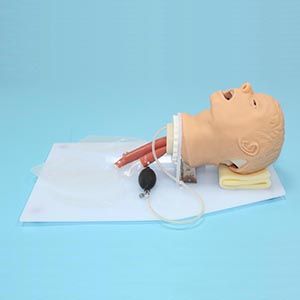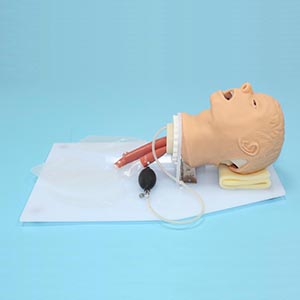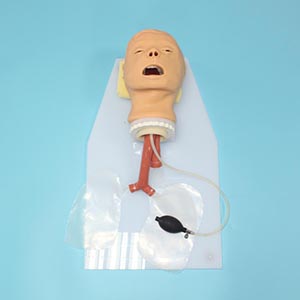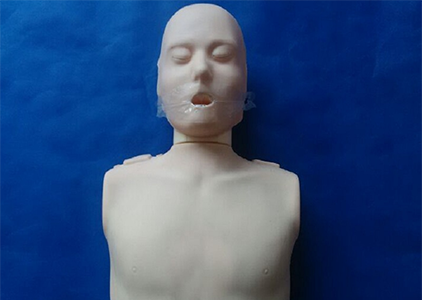
Tracheal intubation is a key clinical skill that is widely used in anesthesia, emergency care, and intensive care. The success of intubation is directly related to the life and death of patients, especially in emergency situations. Therefore, how to improve the intubation skills of medical staff and ensure that the skills can be continuously improved has become an important topic in medical education. The Classical Tracheal Intubation Training Model (hereinafter referred to as the "Intubation Training Model") provides an efficient training method that enables students to gradually improve their skills by simulating real intubation scenarios and practicing repeatedly in a risk-free environment.
Advantages of intubation training model

Classical Tracheal intubation training model
1. High simulation, close to the clinic
The classical tracheal intubation training model uses a highly simulated design to simulate real patient anatomy, including key parts of the mouth, larynx, and trachea. This simulation allows students to accurately perceive the various challenges of intubation, such as correctly positioning the trachea, avoiding misinsertion, and passing through the airway. Long-term use of the training equipment can make students more skilled and confident when facing real patients.
2. Keep improving, through repeated practice
Intubation skills are not just one-time learning, but gradually improved through continuous practice and accumulation of experience. The classical intubation training model provides repeated practice opportunities for students to continuously consolidate and improve their skills. After each training session, students are able to adjust their technical movements through feedback, thereby improving the accuracy and efficiency of the intubation technique.
3. Skill feedback and self-adjustment
Modern intubation training models are generally equipped with real-time feedback systems, which can analyze the intubation movements of students and provide specific suggestions for improvement. For example, the model can monitor key metrics such as depth of intubation, Angle, intubation success rate, and provide feedback after the trainee completes the training. This immediate feedback helps students identify their weaknesses and make targeted improvements.
Data support: Continuous improvement

According to a study of 500 clinical healthcare professionals, regular training using the classical tracheal intubation training model improved intubation success rates by 32%. In addition, the time participants spent intubating was reduced by an average of 20 percent, and complications during intubation were reduced by 15 percent. These data show that regular simulation training has a significant effect on the continuous improvement of intubation skills, especially in improving the operational proficiency and emergency response ability of students.
Another study found that after six months of using the intubation training model, students improved their intubation success rate by nearly 40 percent and responded more quickly and accurately in emergency situations. Continuous simulation training helps reduce intubation failures and complications in real-world Settings, thereby improving patient safety.
Clinical significance: Continuous improvement of intubation skills
Continuous improvement in tracheal intubation skills not only helps medical staff maintain operational proficiency in their daily work, but also enables them to respond quickly in emergency situations such as first aid and anesthesia. The application of intubation training model enables students to simulate and deal with different types of cases, especially some complex and non-standard intubation situations, such as obese patients, upper airway stenosis, etc. These exercises can help medical staff better cope with clinical challenges.
More importantly, through repeated training, students are able to learn from each intubation operation and gradually overcome unfamiliar technical challenges. This repeated practice and skill accumulation provides students with a gradual transition from "theory" to "practice", making skill mastery not only a short-term goal, but a long-term accumulation process.
conclusion
By providing a highly simulated, risk-free training platform, the classical tracheal intubation training model provides medical staff with an opportunity for repeated practice and continuous improvement. Data and studies show that regular use of this training model can significantly improve the success rate of intubation, shorten the operation time, reduce the incidence of complications, and promote the continuous improvement of intubation skills. With the deepening of the training, the trainees are better able to deal with the complex situations in real clinical situations and provide efficient and accurate intubation operations in emergency situations such as first aid and anesthesia. In summary, the classical tracheal intubation training model is not only an important tool to improve intubation skills, but also one of the key factors to promote the development of medical education to a higher level.







Sophie Asveld
February 14, 2019
Email is a crucial channel in any marketing mix, and never has this been truer than for today’s entrepreneur. Curious what to say.
Sophie Asveld
February 14, 2019
Email is a crucial channel in any marketing mix, and never has this been truer than for today’s entrepreneur. Curious what to say.